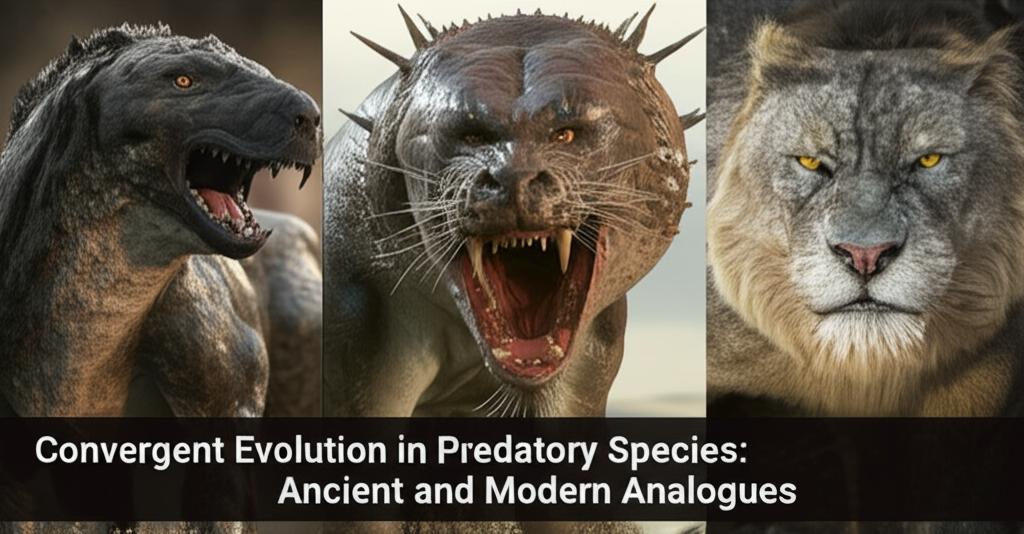Evolution is a powerful force, shaping life in remarkable and sometimes surprisingly similar ways across vastly different lineages. This phenomenon, known as convergent evolution, occurs when unrelated species independently develop similar traits or characteristics to adapt to comparable environmental challenges or to exploit similar ecological niches. In the world of predators, both ancient and modern, convergent evolution offers compelling examples of how natural selection can lead to analogous "designs" for hunting and survival.
One of the most classic examples of convergent evolution in predators is the striking resemblance between the now-extinct thylacine (a marsupial from Australia) and placental canids like wolves. Despite their last common ancestor living over 160 million years ago, both groups evolved remarkably similar skull shapes and body plans suited for a pursuit predator lifestyle in patchwork forest environments. While thylacines didn't hunt in packs or tackle prey as large as wolves did, their overall form was so wolf-like that early naturalists noted the resemblance. Recent research comparing their complete DNA sequences has confirmed this convergence extends beyond superficial looks, with similarities found in regulatory elements of brain genes, hinting at potential behavioral parallels.
Aquatic environments provide numerous instances of predatory convergence. The streamlined, torpedo-shaped bodies of sharks (fish), dolphins (mammals), and the extinct ichthyosaurs (marine reptiles) are a prime example. These disparate groups all evolved this efficient form to move swiftly through water in pursuit of prey. Interestingly, these lineages also independently produced giant filter-feeders, showcasing another layer of convergence in adapting to a different marine niche. A recent discovery of a 225-million-year-old Triassic predatory fish, Saurichthys justicias, further highlights this trend. This ancient fish possessed an elongated, arrow-shaped jaw with sharp, closely-spaced teeth, forming an efficient "fish trap." This jaw morphology is strikingly similar to that of modern predatory fish like pikes and needlefish, despite their independent evolutionary paths, demonstrating how biomechanical and ecological pressures can consistently favor certain predatory adaptations.
The "saber-toothed" morphology is another famous case of convergent evolution among predators. This fearsome dental adaptation, characterized by elongated canine teeth, evolved independently in at least four distinct groups of mammals. These include the true saber-toothed cats (like Smilodon), the nimravids (often called "false saber-tooths"), the unusual South American marsupial relative Thylacosmilus, and even some creodonts and gorgonopsids (earlier mammal relatives). Each of these groups, separated by millions of years and distinct ancestry, arrived at a similar solution for dispatching prey.
Convergent evolution isn't limited to physical form; it can also manifest at the molecular level. For instance, various animals that prey on toxic species have independently evolved resistance to those toxins. Monarch butterflies accumulate toxins from milkweed plants, making them unpalatable to most predators. However, species like black-headed grosbeaks, eastern deer mice, and even certain parasitic wasps and nematodes that regularly consume monarchs have evolved similar genetic mutations that confer resistance to these toxins, mirroring the butterfly's own protective adaptations. Similarly, resistance to snake venom alpha-neurotoxins has evolved multiple times in different mammal lineages, including various carnivores, rodents, and marsupials, through similar mutations in the targeted nicotinic acetylcholine receptor.
Even complex behaviors and sensory systems can converge. Echolocation, the ability to navigate and hunt using sound, evolved independently in bats and toothed whales (like dolphins and sperm whales). Both groups developed this sophisticated sense to locate prey in low-light conditions, whether in the darkness of night or the depths of the ocean.
The driving force behind this widespread phenomenon is natural selection. When different species face similar environmental pressures—such as the need to move efficiently through water, capture fast-moving prey, or overcome the defenses of toxic animals—evolution often favors similar solutions. These "winning designs" can arise through different genetic pathways but result in strikingly similar physical features, behaviors, or physiological adaptations.
Studying convergent evolution in predators, both ancient and modern, provides invaluable insights into the fundamental principles of adaptation and the predictable ways in which life can respond to environmental challenges. It underscores how ecological niches and the physics of an environment can sculpt unrelated organisms into remarkably similar forms and functions, demonstrating the ingenuity and recurring patterns of the evolutionary process.

